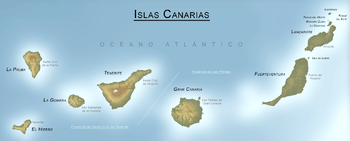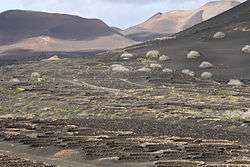Listán negro

Listán negro (also known as Listan Prieto) is a red Spanish wine grape variety that is widely planted in the Canary Islands, particularly on the island of Tenerife where it is a permitted variety in the Denominaciones de Origen (DO) wines of Tacoronte-Acentejo, Valle de la Orotava, Ycoden-Daute-Isora and Valle de Güímar. It is also permitted in the Spanish wine regions of El Hierro, Gran Canaria, La Gomera, La Palma, Lanzarote.[1] Across the Canary Islands more than 5,000 hectares (12,000 acres) are planted to the variety.[2] Listán negro is the black-skin version of the Palomino grape (Listan Blanco) that is used in the production of the fortified wine Sherry.[3]
In 2007, DNA fingerprinting done by the Centro Nacional de Biotecnología in Madrid, Spain discovered that the Mission grape that was widely planted in the earliest New World vineyards in the America was a genetic match to Listán negro.[4] Despite the genetic match, there is enough clonal variation that has occurred over the centuries of geographical separation that the Mission grape of the Americas and the Listán negro grape of the Canary Islands are classified by the Vitis International Variety Catalogue as two separate grape varieties.[5][6] Part of the variation is likely because some of earliest plantings by the Spanish missionaries were from grape seeds[7] which are the result of pollination and sexual propagation and thus more likely to have slight differences from the parent vine than propagation through cuttings.[8]
History

Listán negro was widely planted in the Castile region, where it was known as Listan Prieto, during the 16th century. Settlers to the Canary Island brought the vine with them and eventually it made its way to the Spanish colonies in Mexico and Peru.[4] From there, the grape spread throughout North and South America where it develop clonal variations that became grape varieties that are now known as Mission in California and Mexico, Pais in Chile and Criolla Chica in Argentina.[2]
Wine styles and winemaking
Many winemakers on the Canary Islands favor the use of carbonic maceration to produce a soft fruity, medium-bodied wines that can be highly aromatic.[2] In recent years, producers have been experimenting with oak aging. It is commonly seen as a varietal wine in Tacoronte-Acentejo but in other DOs it is often blended-usually with Negramoll (Tinta Negra Mole), Tintilla and Malvasia Rosada. Some producers on Tenerife also make a sweet wine from Listán negro with grapes that have been dried in the sun.[3]
Viticulture

On the island of Lanzarote, Listán negro is planted in hollowed pits dug into the volcanic soils that is sheltered from the strong Atlantic winds by stone walls that are built around the vines in a semicircle.[3]
Synonyms
Various synonyms have been used to describe Listán negro and its wines, including Almuñeco, Listán negra, Listan Prieto, Palomino negro, Printanier Rouge, Negra Común and Negromuelle.[2][6]
Under the synonyms of Listan Prieto, the Vitis International Variety Catalogue also list Duhamelii, Listan Morado, Molar, Mollar, Mollar de Cadiz, Mollar de Granada, Mollar de Huelva, Mollar Morado, Mollar Negro, Mollar Prieto, Mollar Sevillano, Mollar Zucari, Mollis, Mollissima, Morisca Negra Mole, Sabra Molle, Tinta Molle, Tinta Sabreirinha and Tinta Sobreirinha.[9]
References
- ↑ T. Stevenson "The Sotheby's Wine Encyclopedia", pp. 306–311 Dorling Kindersley 2005 ISBN 0-7566-1324-8
- 1 2 3 4 J. Robinson Jancis Robinson's Guide to Wine Grapes, pp. 97 & 111 Oxford University Press 1996 ISBN 0-19-860098-4
- 1 2 3 Oz Clarke Encyclopedia of Grapes, p. 117 Harcourt Books 2001 ISBN 0-15-100714-4
- 1 2 Alley, Lynn (February 2007). "Researchers Uncover Identity of Historic California Grape: Spanish researchers solve mysteries surrounding the Mission variety and viticulture throughout the Americas". Wine Spectator Online. Retrieved December 27, 2010.
- ↑ VIVC "Mission entry" Accessed: December 27th, 2010
- 1 2 VIVC "Listan negro" Accessed: December 27th, 2010
- ↑ A. Bespaloff Complete Guide to Wine, pp. 191–194 Penguin Books 1994 ISBN 0-451-18169-7
- ↑ J. Robinson (ed) "The Oxford Companion to Wine" Third Edition, p. 729 Oxford University Press 2006 ISBN 0-19-860990-6
- ↑ VIVC "Listan Prieto Entry" Accessed: December 27th, 2010